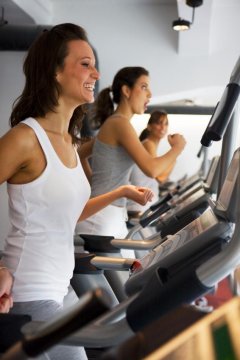 We've written about this topic in the past, but it's worth reviewing the misconceptions about cardio fitness and cardio exercise. (Remember, in our view, "cardio" should be only 1/3 of your exercise program beacuse it does little for muscle and bone strength, and little for athleticism.)
We've written about this topic in the past, but it's worth reviewing the misconceptions about cardio fitness and cardio exercise. (Remember, in our view, "cardio" should be only 1/3 of your exercise program beacuse it does little for muscle and bone strength, and little for athleticism.)
Any exercise, from walking to weight-lifting, makes more demand on heart function than sitting or lying down. So cardio exercise has a spectrum from very light to maximum intensity. Simply put, the core purpose of "cardio" exercise is to maintain or upgrade heart function (cardiac condition is measured by things like a Cardiac Stress Test with Echo, Stroke Volume, Cardiac Output, cardiac vasculature, and left ventricle size to some extent). Like weight-lifting for skeletal muscle, it requires stress, relative to your conditioning and medical condition.
With lighter stresses (eg non-sprint, endurance-oriented swimming laps, jogging, rowing, stair machine, elliptical, etc) we are putting our hearts to some use, but we are working more on general time endurance than cardio. (Lots of people do those things thinking that they involve fat-burning, but don't count on that to work if you do 1 hour/day.) For people who are not training for specific goals, building endurance is great for life. Nobody wants to slow down or feel tired during ordinary recreational activities like sports or hiking. These non-sprint exercises aim for around 70% of one's max heart rate to make it worth your precious time.
The higher the physical demand - the intensity of an exertion for your level of fitness - the more you are training your heart rather than just using it. The highest levels of exertion (say, with sets of deadlifts near 80% of your max, or with 30-second sprints) are anaerobic and can push your heart rate to 90% of your max. That heart-pounding rest time or slow time is to catch up on oxygen.
For endurance, an hour of lap swimming, cycling, jogging, elliptical, stair machine, ski machine, rower, etc at around 70% of your max heart rate is where you ought to be, if in decent health. Over time, you will need to raise the speed to get to those heart rates. These exercises do nothing much to build muscle or bone strength.
For maximum cardiac fitness (with bonus endurance benefits as well), mixing in sprints which get your HR to 80-90% of your max should be included. Bursts of intensity. In the Maggie's Fitness for Life program, the other good sources of intense cardiac stress are the powerlifts and calisthenics. Ideally, some of all of those because there is more to fitness than cardiac fitness. Fitness is a package deal.
An interesting detail is that to up your game in any area of exertion, it's always a good idea to do what you do not usually do. Explosive linebackers get better with distance running, distance runners get better with weights and sprints, heavy lifters get better with calisthenics. Balance.


 We've written about this topic in the past, but it's worth reviewing the misconceptions about cardio fitness and cardio exercise. (Remember, in our view, "cardio" should be only 1/3 of your exercise program beacuse it does little for muscle and bone strength, and little for athleticism.)
We've written about this topic in the past, but it's worth reviewing the misconceptions about cardio fitness and cardio exercise. (Remember, in our view, "cardio" should be only 1/3 of your exercise program beacuse it does little for muscle and bone strength, and little for athleticism.)